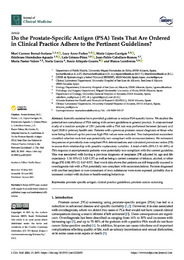Por favor, use este identificador para citar o enlazar este ítem:
https://hdl.handle.net/11000/35356Registro completo de metadatos
| Campo DC | Valor | Lengua/Idioma |
|---|---|---|
| dc.contributor.author | Bernal-Soriano, Mari Carmen | - |
| dc.contributor.author | Parker, Lucy Anne | - |
| dc.contributor.author | López-Garrigós, Maite | - |
| dc.contributor.author | Hernández-Aguado, Ildefonso | - |
| dc.contributor.author | Gómez-Pérez, Luis | - |
| dc.contributor.author | Caballero-Romeu, Juan-Pablo | - |
| dc.contributor.author | Pastor-Valero, Maria | - |
| dc.contributor.author | García, Nuria | - |
| dc.contributor.author | Alfayate-Guerra, Rocío | - |
| dc.contributor.author | Lumbreras, Blanca | - |
| dc.contributor.other | Departamentos de la UMH::Salud Pública, Historia de la Ciencia y Ginecología | es_ES |
| dc.contributor.other | Departamentos de la UMH::Patología y Cirugía | es_ES |
| dc.date.accessioned | 2025-01-27T15:56:47Z | - |
| dc.date.available | 2025-01-27T15:56:47Z | - |
| dc.date.created | 2021-06-16 | - |
| dc.identifier.citation | J Clin Med . 2021 Jun 16;10(12):2650 | es_ES |
| dc.identifier.issn | 2077-0383 | - |
| dc.identifier.uri | https://hdl.handle.net/11000/35356 | - |
| dc.description.abstract | Scientific societies have provided guidelines to reduce PSA-specific harms. We studied the potential non-compliance of PSA testing with current guidelines in general practice. A cross-sectional study of a random sample of 1291 patients with a PSA test was performed between January and April 2018 in primary health care. Patients with a previous prostate cancer diagnosis or those who were being followed-up for previous high PSA values were excluded. Two independent researchers classified whether each test was potentially non-compliant with recommendations. We estimated frequencies of potentially non-compliant PSA determinations and calculated prevalence ratios (PR) to assess their relationship with possible explanatory variables. A total of 66% (95% CI: 62-69%) of PSA requests in asymptomatic patients were potentially non-compliant with the current guideline. This was associated with having a previous diagnosis of neoplasm (PR adjusted by age and life expectancy: 1.18; 95% CI: 1.02-1.37) as well as being a current consumer of tobacco, alcohol, or other drugs (PR: 0.80; 95% CI: 0.67-0.97). Real world data shows that patients are still frequently exposed to overdiagnosis risk with a PSA potentially non-compliant with recommendations. Patients diagnosed with another neoplasm or non-consumers of toxic substances were more exposed, probably due to increased contact with doctors or health-seeking behaviour. | es_ES |
| dc.format | application/pdf | es_ES |
| dc.format.extent | 12 | es_ES |
| dc.language.iso | eng | es_ES |
| dc.publisher | MDPI | es_ES |
| dc.rights | info:eu-repo/semantics/openAccess | es_ES |
| dc.rights | Attribution-NonCommercial-NoDerivatives 4.0 Internacional | * |
| dc.rights.uri | http://creativecommons.org/licenses/by-nc-nd/4.0/ | * |
| dc.subject | clinical practice guidelines | es_ES |
| dc.subject | prostate cancer | es_ES |
| dc.subject | prostate-specific antigen | es_ES |
| dc.subject | screening | es_ES |
| dc.title | Do the Prostate-Specific Antigen (PSA) Tests That Are Ordered in Clinical Practice Adhere to the Pertinent Guidelines? | es_ES |
| dc.type | info:eu-repo/semantics/article | es_ES |
| dc.relation.publisherversion | 10.3390/jcm10122650 | es_ES |

Ver/Abrir:
Do the Prostate-Specific Antigen (PSA) Tests That Are Ordered in Clinical Practice Adhere to the Pertinent Guidelines.pdf
20,8 MB
Adobe PDF
Compartir:
 La licencia se describe como: Atribución-NonComercial-NoDerivada 4.0 Internacional.
La licencia se describe como: Atribución-NonComercial-NoDerivada 4.0 Internacional.
.png)